Folk dance moves - Grand Square,
Grand Rectangle, Grand Galaxy and other options.
Updated March 2017.
This was originally part of the main SeeRed
folkdance webpage. It has been moved here because the main
page was getting a little too large. You are advised not to try to print these diagrams -
the ink will cost you a lot of money! Some printer-friendly diagrams will appear soon.
Despite not being a 'natural born
dancer' I have become quite proficient. My dance diary for 2016 shows how much fun and
exercise can be had for a few hundred pounds a year.
Highlights of my dance year in 2016 are here - see if they
encourage you to take up the hobby!
Since taking up dancing over 10 years ago I estimate I have danced about 30,000 times and
with hundreds of different women.
Principal links to folk dance material on this website.
Grand Square: Danced starting from a square formation (four or
six couples). This often causes far more problems than it ought to because it is rarely
explained properly to beginners. Easier with a few diagrams!
The main square of a 'square set' becomes in effect four smaller squares for the
purposes of the grand square figure.
Each person moves ONLY around the four sides of his or her small square.
Most often, the move is immediately reversed. It is important to keep close to your
correct path on the dance floor. When there are six couples (quite rare and called a grand rectangle - a diagram is shown below)
four of them keep close to their partners and move as single entities. Usually, in time
with the music, it is three steps, turn, three steps, turn,
three steps, turn, three
steps (back where you started). Each
turn here is just a rotation (at corners of each small square). Holding hands
occurs as you move either forwards or backwards alongside another person. For example, the
head couples will be holding inside
hands as they undertake their first move (inwards to meet at the centre of the large
square). The side couples will initially face each other and move backwards and on their
own towards a corner of the large square. Other variations of the grand square include the
grand triangle (I'll add a diagram when I can remember how it goes...).
Whenever you have to do a simple grand square figure, just think of four small coloured
squares on the floor, and you'll have no problems!
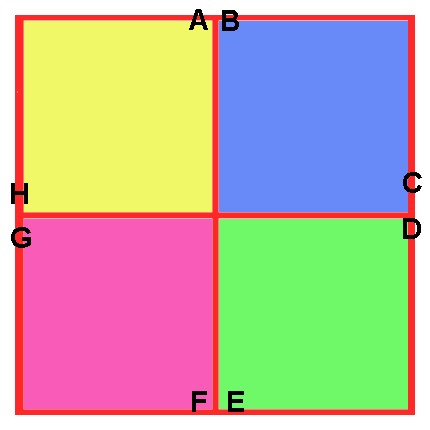 |
The basic Grand Square as danced in a normal square set for
4 couples - 8 people. Think of the main square as four smaller squares. Each couple may
initially be standing close to their partner as shown: couples AB and FE are head couples,
CD and GH are side couples. Each
PERSON (NOT each couple) should think of himself or herself as being a particular colour -
for example, A and H are yellow people. D and E are green people, and so on.
Here is the key to it all: each
person will walk ONLY alongside the red lines that surround their own coloured square -
they will never walk anywhere else.
Read it again! They will walk ONLY
alongside the red lines and ONLY around their own coloured square.
The reason why two sides of each
small square are walked backwards is simply to maintain eye contact - rather than turning
your back on your current or a prospective future partner. |
|
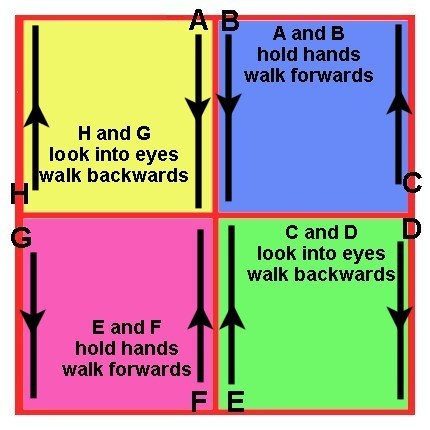 |
The Grand Square: first of four (or eight) moves. The starting moves for all 8 dancers are
shown. All 8 people walk 'up or down' the set in this first move.
A and B and E and F hold inside
hands and walk towards the centre of the large square.
F (a man) should be gazing into the
eyes of A (a woman) and likewise B and E. These two sets of strangers will shortly be
holding hands.
After this first move dancers A, B,
E and F will all be at the centre of the large square.
Dancers C, D, G and H will have
moved to the corners of the large square.
F and E will now turn to face each
other, as will A and B. B and E will now hold inside hands, as will A and F.
Dancers C, D, G and H will turn to
face - D facing G and C facing H, looking at each other from a distance. |
|
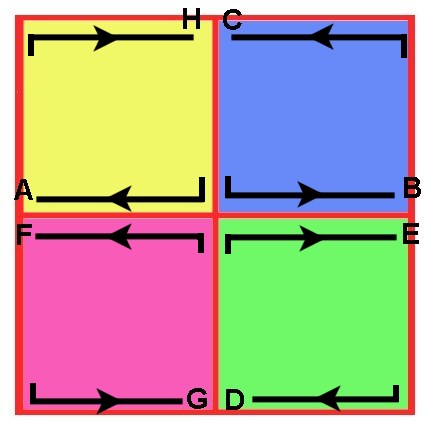 Walk
each side in a straight line using three steps then do a sharp turn. You can say to
yourself 1,2,3,turn, 1,2,3,turn and so on. |
In the second move, dancers will complete the second side of
THEIR COLOURED SQUARE. The lines show the second moves (all persons now walking sideways).
Dancers are shown positioned ready to walk their third side. D and G will hold hands when
they meet, as will C and H. Both these new couples will turn to face up and down the set. Thus the roles are now reversed, people who
started as side couples are now in head positions and will do exactly as the head couples
did to start with - holding hands they will move towards the centre of the large square.
People who started as head couples
are now side couples, B and E will turn to face each other (as will A and F) and move
backwards away to a corner.
Each PERSON will then complete
walking HIS OR HER OWN COLOURED SQUARE to get back to starting positions, all four sides
having been walked in an anticlockwise or clockwise direction!
Often, the whole sequence is then
reversed : each person will retrace his/her own steps exactly, walking forwards when he
previously walked backwards, and vice-versa! |
|
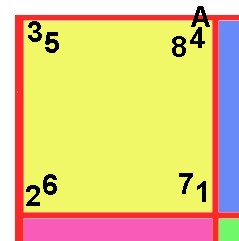 |
Considering dancer A (a woman) she will walk either 4 or 8
sides of the yellow square, depending on whether the whole sequence is reversed. She will first walk to position 1, then 2
then 3 then to 4, all in an clockwise direction. From 1 to 2 and from 2 to 3 she will have
walked backwards.
At her starting position, she may
need to reverse the whole sequence - walking now anticlockwise. Thus 4 to 5 and 7 to 8
will be walked backwards.
It gets more interesting when there
are five or six couples.......
Some dances have a greater
complexity of moves based on the grand square - but few callers attempt them! |
|
One of the simplest 'modifications' of a
basic grand square is danced for five couples. The four original couples (shown above) do
exactly as before. The extra couple 'do their own thing'. The dance is progressive.
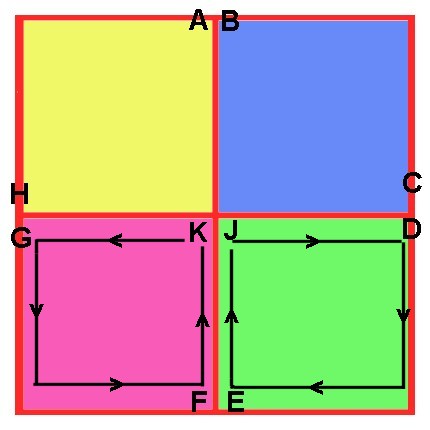 |
The Grand Square involving five couples, showing the first
four moves of the 'extra' couple J (woman) and K (man). They start the dance in the middle
of the set facing the couple A + B (no. 1 couple in a square set) The starting move for J and K is to turn to
face each other then walk backwards. All other dancers will move up or down the set.
Because of this, dancers J and K never collide with anyone else (in theory).
Dancers A to H inclusive all do
exactly as they would in a normal grand square. The time taken to complete this grand
square is the same as when danced with only four couples.
J and K can then reverse their
entire sequence of four moves, provided A to H reverse theirs! Dances that include this
move are progressive, each couple will get a turn in the middle.
There is nothing to stop another
'extra' couple using the yellow and blue squares, mirroring J and K. Any progression would
be confusing - maybe swapping over the 'original' and 'extra' couples! |
|
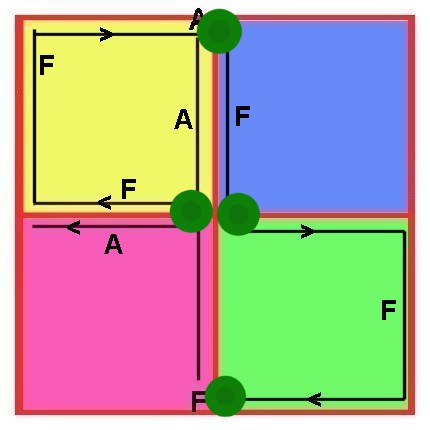 Grand
Galaxy: Dancer F (man) will walk three sides of the yellow and green squares. His partner
(E) will walk three sides of the blue and pink squares! |
The normal Grand Square (4 couples) can be varied if a new rule is
added - that whenever you walk forwards to meet someone, you star through
(see below). In dancing this variation, called a Grand Galaxy, forget everything you once
knew about keeping in your own quarter of the large square! Everyone should get back where
they started.
A and F move in to meet at the centre of the large square, but star through
when they do, to move outwards as shown. Similarly for B and E (not shown). In the third
move, F will walk backwards up the side of the large square whilst A will walk down (not
shown).The complete
path of one dancer (man = F) is shown. He walks eight sides to get home, rather than just
4 as in the normal Grand Square. It is best walked slowly as a demonstration.
Dancer F stars through
at the four locations shown as dark green circles, the second time being with his partner
(E) at the top of the large square and the last being with E as they both get home.
Dancers who have met and have then
to move away from each other do so in the normal way, walking backwards to maintain eye
contact. |
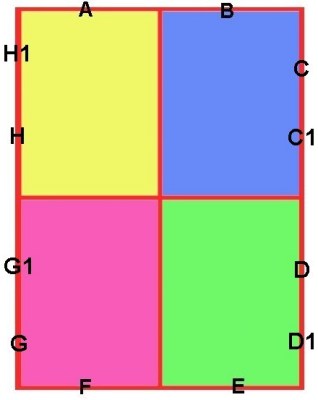 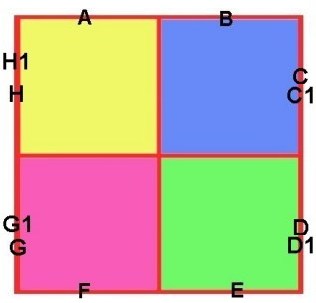 The grand rectangle starts as a rectangle (left diagram)
with all six couples side by side. However, it can compress to close to a square formation
(right diagram) as the side couples move close to each other. For the purposes of
the grand rectangle move itself, the side couples (C+C1 etc) should think of themselves as
being trussed up together - or touching noses if they prefer! This compact square may
naturally expand a little (again into more of a rectangle) as the side couples need more
space to undertake other moves.
|
The normal Grand Square (4 couples) can become a Grand
Rectangle for six couples. Two couples are heads (as normal) but on each side there are
two couples, initially standing side by side.
Each of the four side couples turn to FACE THEIR PARTNER, they move close to their partner
and thereafter move as a single entity, doing exactly what a single side person would
normally do.Dances
that include this move are progressive - you often change partners as well as positions
around the rectangle.
|
|
back to main folk dance page
What type of clothes are most suitable for folk dancing? - click here for my opinions.
SeeRed Local Folk Dance section
Sidmouth Folk Festival section







